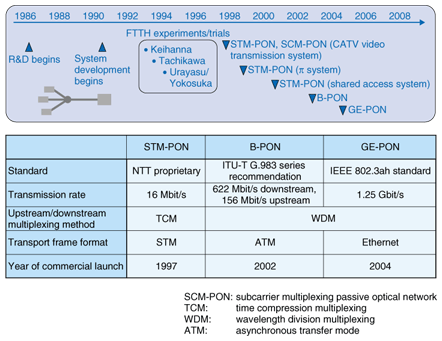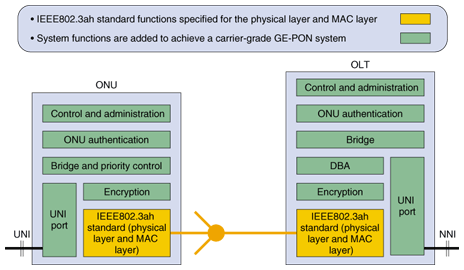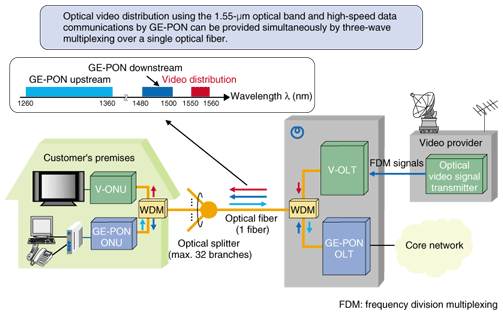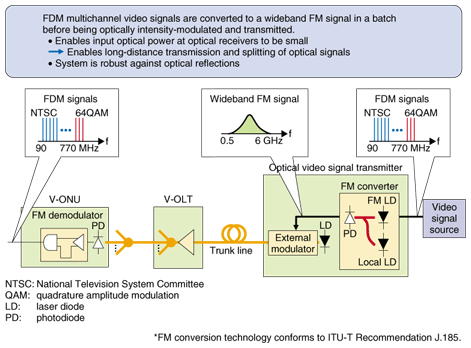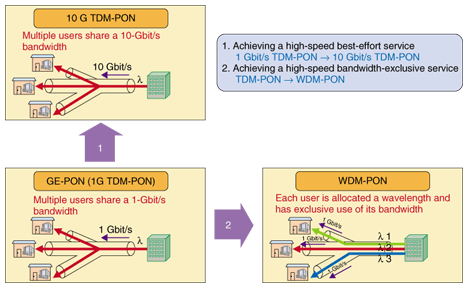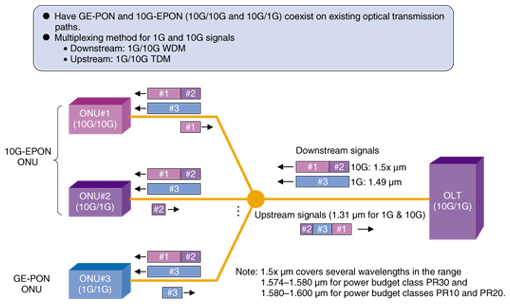 |
|||||||||||||||||
|
|
|||||||||||||||||
|
Special Feature: NTT Tsukuba Forum 2007 Workshop Lectures 2 Vol. 6, No. 5, pp. 9–15, May 2008. https://doi.org/10.53829/ntr200805sf2  Optical Access Systems: Present State and Future DirectionsAbstractThe rapid spread of fiber-to-the-home (FTTH) access is helping to bring high-quality, high-reliability broadband services closer to people. This article describes the present state of passive optical network (PON) optical access systems that support the expansion of FTTH and discusses future directions of next-generation PON systems.
1. Present state of broadband accessDriven by the rapid spread of the Internet, demand for faster and cheaper access lines has been rising, and the conversion of information-communications to broadband systems has been progressing at an astounding pace. In broadband access, which began with the asymmetric digital subscriber line (ADSL) system using existing telephone lines, the number of subscribers initially increased as access speeds climbed. However, the limitations and problems inherent to metallic cable, such as limited transmission distance and line noise, put a cap on transmission speeds. Consequently, the need for fiber-to-the-home (FTTH) systems using optical fiber was felt. These systems have no such performance limitations, and at present, the shift from ADSL to FTTH is progressing well. There were a number of factors behind this shift. The main ones were (1) a rising demand in society for faster Internet access, (2) the ability to provide a POTS-quality telephone service called Hikari Denwa by FTTH (POTS: plain ordinary telephone service), and (3) the ability to provide FTTH services at low monthly usage fees through the use of passive optical network (PON) technology, which has highly economical features. The number of broadband access subscribers in Japan as of the second quarter of 2007 was 13.79 million by ADSL, 9.7 million by FTTH, and 3.69 million by CATV (cable television) Internet (source: press release of Ministry of Internal Affairs and Communications). Here, access by CATV Internet continues to increase slowly but surely, while that by ADSL is on a downward trend. The number of FTTH subscribers, however, is increasing dramatically. The pace of this increase has also jumped. If we look at the change in number of subscribers on a quarterly basis, we see that FTTH has been boosting its numbers by about 800,000 lines every quarter since 2006. In contrast, the second quarter of 2006 marked a turning point for ADSL when its number of subscribers began to decrease. Soon after the beginning of 2007, the number of subscribers to NTT's B FLET'S optical-access service, which had been increasing rapidly, finally surpassed that of NTT's FLET'S ADSL service, which had already started to fall, although ADSL still held the top position in Japan overall. 2. Optical access systems2.1 Features and requirements of the access networkThe access network connects customer premises to a telecommunications carrier. Its transmission paths form districts centered about the telecommunications carrier. This network must be highly reliable and economical as a communication infrastructure. Moreover, it must be adaptable to changes in service demand. In the case of an optical access system, connections are made from an optical line terminal (OLT) in the telecommunications carrier's building to an optical network unit (ONU) in the customer's premises via an underground or aerial cable. The major system configuration is based on a PON in which optical fiber branches at splitters to achieve 1-to-n connections with customer premises instead of 1-to-1 connections. A PON system must satisfy the following requirements.
2.2 Configuration and features of the GE-PON systemNTT has developed a number of PON systems to date. In fact, its history of researching and developing PON systems goes back about 20 years (Fig. 1). Researchers first set to work on this technology in 1986 and began to develop genuine systems in 1990. Then, after a number of field trials, the first commercial deployment of a PON system took place in 1997. There are three main types of PON systems: synchronous transfer mode PON (STM-PON), broadband PON (B-PON), and Gigabit Ethernet PON (GE-PON).
The GE-PON system, which is currently the mainstream FTTH system, features high-speed data communications up to 1 Gbit/s on a single optical fiber, a simple equipment configuration using Ethernet technology, and high affinity with high-speed Internet access. The basic configuration of a GE-PON system consists of a single optical fiber and an optical splitter with up to 32 branches positioned between the OLT and ONUs. The system uses the 1.31-µm band in the upstream direction and the 1.49-µm band in the downstream direction to transmit signals. At the customer's premises, the ONU is supplemented with a home router to provide both Internet and Hikari Denwa services. On the NTT side, the OLT connects to the core network as well as to an operation support system (OSS) for maintenance and monitoring via a data communication network. 2.3 GE-PON function blocksIn the ONU and OLT, only the section concerned with the physical layer and MAC (media access control) layer is specified by IEEE802.3ah standard functions. Consequently, to achieve a carrier-grade GE-PON system, necessary functions (system functions) must be added to both the ONU and OLT (Fig. 2). The system functions common to both ONU and OLT include maintenance, authentication, bridging, and encryption functions. The ONU has priority control and user-to-network interface (UNI) port functions. The OLT has dynamic bandwidth allocation (DBA) and network-to-node interface (NNI) port functions.
2.4 DBA functionDynamic bandwidth allocation is a particularly important function in a GE-PON system. It can take the total bandwidth available for sharing by multiple ONUs and allocate the bandwidth to each ONU dynamically according to the amount of upstream traffic. It can also transmit variable-length Ethernet frames with appropriate timing and order to achieve high bandwidth efficiency and low delay, resulting in high TCP throughput. The DBA function can set a minimum guaranteed bandwidth and maximum bandwidth and define classes based on delay, which enables the support of multiple service classes (multi-QoS). For example, the DBA function can allocate the maximum bandwidth to a certain ONU if the upstream bandwidth is free, or limit that ONU to the minimum guaranteed bandwidth at times of severe congestion. When congestion is moderate, the function will allocate bandwidth accordingly. The key feature of this algorithm is that each ONU sends the OLT not only the queue length in its request message but also information about frame boundaries. In particular, an ONU notifies the OLT of the amount of data in its entire upstream buffer (stored-data 1) and the amount of data stored up to the data-frame boundary below but nearest to a preset data threshold value (stored-data 2). When it receives this information, the OLT selects either stored-data 1 or stored-data 2 according to the volume of upstream requests and allocates the bandwidth accordingly. That is to say, the OLT selects stored-data 1 when the number of ONUs performing communications is small, but when this number is large, it decreases the number of ONUs for which stored-data 1 is selected and increases the number of ONUs for which stored-data 2 is selected. Bandwidth is controlled by the OLT in this way. In short, the OLT allocates bandwidth appropriately for the frame boundaries stored at each ONU, resulting in a mechanism where no bandwidth is wasted. 3. Optical video distribution system3.1 Optical video distribution system by three-wave multiplexingThis system transmits communication services and video services on a single optical fiber by superposing video transmission signals onto the optical fiber used for a GE-PON system by using three-wave multiplexing. The video signal is input as a frequency-division-multiplexed signal from the optical video transmission equipment of a video provider into a video distribution optical line terminal (V-OLT), where it is optically amplified and split. The signal is then combined with the GE-PON upstream and downstream signals at a wavelength-division-multiplexing (WDM) filter so that all three signals are transmitted on the same optical fiber. The 1.55-µm optical wavelength is used for the video signal. At the customer's premises, the video signal, which has been transmitted together with the communication signals on the same optical fiber, is now separated by a WDM filter. It is then input into a video distribution optical network unit (V-ONU) for viewing on a TV terminal connected to the unit (Fig. 3).
The strong point of this optical video distribution system is that multichannel video signals can be transmitted to the premises of each customer. The 770-MHz electrical frequency band used here can transmit about 100 carriers. The number of channels that can be transmitted per carrier is usually 4–5 channels for standard-definition television (SDTV) and 1 for high-definition television (HDTV). This means that the maximum number of channels that can be provided over one optical fiber is about 500 SDTV channels plus about 100 HDTV channels. 3.2 FM conversion technologyThe key technology behind this optical video distribution system is frequency modulation (FM) conversion. Instead of frequency-division-multiplexed video signals being transmitted directly, they are converted in a batch into a broadband FM signal. This makes the input optical power at an optical receiver small, which enables long-distance transmission and splitting of optical signals. This technology is also robust against optical reflections. If we look at the optical-signal flow, we see that the frequency-division-multiplexed multichannel video signals from the video-signal source are first converted to a wideband FM signal and optically intensity-modulated within the optical video signal transmitter. This signal is then transferred to a trunk line. Then, at the V-OLT, the wideband FM signal is optically amplified and split and transmitted to the V-ONU at the customer's premises. Here, it is subjected to optical-to-electrical conversion and finally converted back to the original frequency-division-multiplexed signals by an FM demodulator (Fig. 4).
4. Next-generation PON systems4.1 Trends in PON systems and future directionsTransmission rates in PON systems have been reaching new heights in the form of STM-PON, B-PON, and GE-PON, which have all been commercially deployed. Next-generation PON systems are positioned as future systems that will provide transmission capacities that exceed those of existing PON systems. These next-generation PON systems have three main requirements. They must be able to use existing 32-branch optical transmission paths using optical splitters, be able to coexist with existing GE-PON and optical video distribution systems, and be designed so that existing systems can easily be upgraded to a next-generation system. We can consider two directions for next-generation PON systems based on the characteristics of the traffic to be transferred: 1) best-effort service and 2) bandwidth-exclusive service. There are several candidates for next-generation PON systems that will give such services high-speed features (Fig. 5). Note that GE-PON, the mainstream FTTH system at present, is a time-division-multiplexing (TDM) type of PON in which multiple users share a bandwidth of 1 Gbit/s.
In addition to these two approaches, we can consider a hybrid system that combines these two types. 4.2 Example of a next-generation PON systemWith regard to a 10-Gbit/s TDM-PON system, the IEEE P802.3av 10G-EPON Task Force has been established, and standardization of the physical layer as 10G-EPON is progressing (EPON: Ethernet passive optical network). Targeted systems include a symmetrical system with 10 Gbit/s downstream and 10 Gbit/s upstream (10G/10G) and an asymmetrical system with 10 Gbit/s downstream and 1 Gbit/s upstream (10G/1G). Two key issues surround the development of a practical 10-Gbit/s TDM-PON system: achieving transmission characteristics that can use GE-PON optical transmission paths and achieving coexistence with existing systems (GE-PON and optical video systems). With regard to the former, studies on forward error correction are being conducted to compensate for deterioration in transmission characteristics caused by higher speeds and on the application of optical amplifiers. With regard to the latter, studies are being conducted on wavelength arrangement. Having GE-PON and 10G-EPON (10G/10G and 10G/1G) coexist on existing optical transmission paths will require the multiplexing of 1- and 10-Gbit/s signals. One possible solution is to use WDM in the downstream direction, with 10-Gbit/s signals being transmitted using a different wavelength from 1-Gbit/s signals, and TDM in the upstream direction, with 1- and 10-Gbit/s signals being transmitted using the same wavelength (Fig. 6). This configuration can accommodate both GE-PON- and 10G-EPON-type ONUs in the same PON. Achieving coexistence in this way will facilitate a smooth migration from 1G to 10G systems.
5. ConclusionOptical access systems of the future will be required to operate even faster and have even greater capacities, to be even more economical, and to provide higher levels of usability. We plan to continue our R&D efforts toward next-generation optical access systems based on coexistence with existing systems with the aim of providing our customers with more reliable and comfortable broadband access. |
|||||||||||||||||








